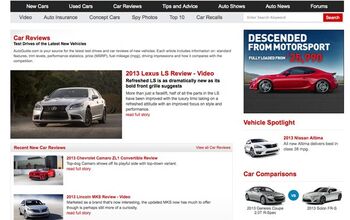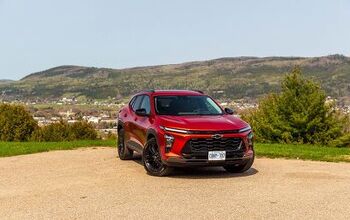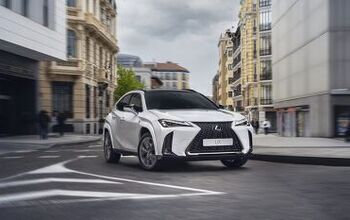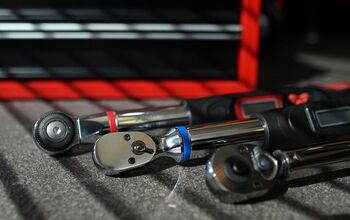2013 Chevrolet Trax Review

It’s mid-December and we’re somewhere outside Ottawa, Canada on a barely traveled road. With snow falling, temperature dropping and wildlife frolicking, it’s almost certain that this trip is going to end with a mishap.
FAST FACTS
| 1. All new for 2013, the Trax is available in over 140 markets, including Mexico and Canada, but not the U.S. |
| 2. Under the hood of the Trax is a 1.4L turbocharged four-cylinder engine from the Chevy Sonic, which puts out 138-hp and 148 lbs-ft of torque. |
| 3. An optional Active-On-Demand All-Wheel-Drive system is exclusive to the Trax and the Trax-based Buick Encore. |
| 4. Chevrolet MyLink is getting expanded app selection including BrinGo navigation which is a $50 smart-phone app which adds navigation to the infotainment system. |
Our all-season tires could choose to not grip going up, or down one of the many hilly routes along the way or when a suicidal deer jumps onto the road. The AWD system could prove to be understeer happy, sending me into a ditch or tree. The unsalted path could choose to spring some ice under our wheels, sending the car careening into oncoming traffic. Or I could just get lost, with no built-in navigation system, or cell-service coverage in the area.
Fortunately for me, none of this happens and Chevrolet’s new compact SUV, the Trax, is largely to thank. With its pluckiness and sheer determination, the Trax managed to get me out of every situation, one way or another.
TRAX LEADS TO CANADA
The Trax is a small vehicle in many ways. It’s small in price, starting at just $18,495 (CAN), which makes it more affordable than base models of the Nissan Juke, Hyundai Tucson and Kia Soul, although it’s not as inexpensive as the often-forgotten Suzuki SX4. When you start ticking the boxes like our 2LT equipped model, the price does get closer to its competition. Our vehicle was decked out with the automatic transmission and all-heel drive and came to $27,450. Overall value for the American vehicle is great.
Did that say American? Sorry, despite the Trax being sold to over 140 markets, it won’t make the move to the United States, which is why we’re in Canada testing out the local vehicle. The decision makes sense, as American buyers tend to opt for bigger vehicles, and already have access to the Buick Encore – a mechanically similar machines.
Canadians are often used to the out-of-city adventure. And for outdoor excursions ranging from snowboarding to camping a raised ground clearance or off-road capable drivetrain is preferred, as is storage space. Fortunately, the Trax acts like a good Canadian boy and scores well on all those points.
MAKING ITS OWN TRAX
The Trax follows through on the Canada-market decision by being offered with a unique and smart AWD drivetrain, which, thankfully, our tester was modeling. Despite being paired with a fairly unimpressive turbocharged 1.4-liter engine, the Trax manages to get all 138-hp and 148 lbs-ft of torque to the ground thanks to a clever AWD sleight-of-hand which always launches the car with all four wheels. This means that slip from a stop is non-existent, and AWD is active even in reverse.
Interior space is also not an issue thanks to the eye-popping amount of storage space. Everywhere you look in the car there’s a cubby, cup holder, coin dish, magazine pocket, or some kind of hidden compartment. For those who travel with their hockey-sticks, snowboards and whatever equipment they have, you’ll find the rear-trunk large enough for bags and the 60-40 rear-seats fold down to accompany larger items. Need more space? The front passenger seat also folds flat.
MYLINK EXPANDS TRAX VALUE
In terms of pricing, and packaging the Trax is well suited to the young adventurer. Its secret weapon is the slick new Chevy MyLink infotainment system. Also seen on the Spark, MyLink is a vibrant touch-screen that’s fast and responsive, and features tight integration with your smartphone. When cell-service is available, an iPhone can provide tunes from a Swiss reggae station (or numerous others) thanks to the TuneIn App integration, but once our trip started moving away from the city, we lost connectivity and our funky beats. Thanks to MyLink’s clever tricks, that was the last thing we lost.
Despite being in unfamiliar territory our route directions were a little vague, and we had to be on the lookout for obscure French street names for our next direction. Ordinarily, this would have caused a bit of frustration and hesitation at every intersection, but luckily we had the BrinGo app on a provided smart-phone pre-downloaded by GM. The $50 app brings honest-to-goodness GPS mapping and navigation to the Chevy MyLink system. Even better is that it doesn’t use mobile data in order to work. When the app is bought, it downloads the map at that time, meaning that you won’t lose your way, even when you lose your cell-service.
IN AND OUT OF TOWN
With the spacious and now well connected interior, the only thing left to worry about is the drive itself. In the city, the Trax is like any other small compact. That is to say it is properly proportioned for stress-free commuting in tight spots. Visibility is good, and the Trax even featured handy convex segments in the side-view mirror to assist with bikers and other motorists hiding out in potential blind-spots. The smaller steering wheel is light and nimble, and allows for quick lane changes. Pair all those elements with the rear-view camera that MyLink equipped vehicles get and the Trax dances in the city like Jeff Skinner on the ice.
Outside of the city and the Trax’s flaws become apparent. The small 1.4L turbo engine is buzzy at higher speeds and overtaking requires extra words of wisdom like “Go little Trax! Go!” Maybe a Don Cherry sound bite might help it out. This drab engine means that any towing capability is non-existent, pointing drivers who need that functionality towards the Hyundai Tucson.
The upside of the small turbocharged engine is that it’s quite good on gas, with 7.8 L/100 km (30 mpg) in the city and 5.7 L/100 km (41 mpg) on the highway. Our AWD equipped tester was rated at 8.7 L/100 km (27 mpg) city and 6.5 L/100 km (36 mpg) highway, and proved to be great during the earlier stages of our trip in and around town, but as the route got more hairy, fuel economy suffered a bit. Overall our tester delivered 8.7L/100 kms (27 mpg) on our trip, which isn’t bad considering the conditions experienced.
On the many hills we encountered, the small crossover didn’t disappoint. The 1.4L turbo has enough torque down-low to help the Trax get going up an incline. However, once the hills started getting snowy and icy, some of the clever extras made the Trax really stand out.
For starters, since our tester wasn’t equipped with snow-tires when we needed them, braking and grip was lackluster. Fortunately, the Trax has a select-gear mode so we could engine brake when needed, or hold a gear for better power delivery in messy conditions. In this manner, the Trax was surprisingly capable. Sure we weren’t rocks crawling, or navigating tricky trails on unstable ground, but for this typically Canadian adventure, the Trax handled every bit of snow, ice, mud and terrain.
YAWN-INDUCING STYLE
So the Trax proves itself to be practical, versatile and affordable. The extra value of the MyLink infotainment system is also a great feature, but there is a huge problem for the Trax, especially when its target demographic is considered. Look at the Trax’s main competition and it’s easy to see what I mean; the Kia Soul, Nissan Juke and even the Hyundai Tucson all have a distinct amount of style.
Not only is the Trax lacking in style compared to these rivals, but it’s tough to even single out a Trax in a line-up of other Chevy crossovers. The Trax could have used some fashion advice from the spunky Sonic rather than the characterless Cruze.
Inside, top-spec LTZ models feature leather upholstery and heated front seats. Our LT tester sported a leather wrapped steering wheel, and only had non-heated cloth seats, like the base spec LS model. Like the exterior, the Trax’s interior isn’t exciting, save for the information cluster. Following in the same footsteps as the Sonic, the Trax has a modern-looking, simplified display which gives all the appropriate driving information. Unlike other cars which clutter up the information cluster with media information, the Trax saves that for the MyLink display, which is handy. It’s also worth noting that base Trax models don’t come equipped with a CD player, but do have Bluetooth connectivity and auxiliary input.
Interior quality is lacking. While a few controls use soft-touch materials, other spots around the doors and dash pack hard plastic. Additionally, some interior bits in our tester made a racket, rattling during higher speed trails, though we should point out we were driving pre-production models.
THE VERDICT
The compact city SUV is an under-appreciated market segment. This Chevy entry ticks the boxes in many ways and is surprisingly capable in trickier driving conditions. In urban environments, the Trax is as lovely as a city car, although on the open road it suffers a bit with its underpowered engine.
With more good points than bad, the new MyLink platform is proving to be a killer app for the connected crowd. The Trax lacks a finishing touch due to its uninspired styling both inside and out, though its uniqueness overall, as well as its ability to deliver crossover functionality in the city mean that for many it will be good enough.
LOVE IT
- Great AWD system
- Versatile and practical cargo space
- MyLink smart-phone integration
LEAVE IT
- Bland styling
- Poor performance
- Cheap feel

Sami has an unquenchable thirst for car knowledge and has been at AutoGuide for the past six years. He has a degree in journalism and media studies from the University of Guelph-Humber in Toronto and has won multiple journalism awards from the Automotive Journalist Association of Canada. Sami is also on the jury for the World Car Awards.
More by Sami Haj-Assaad































Comments
Join the conversation